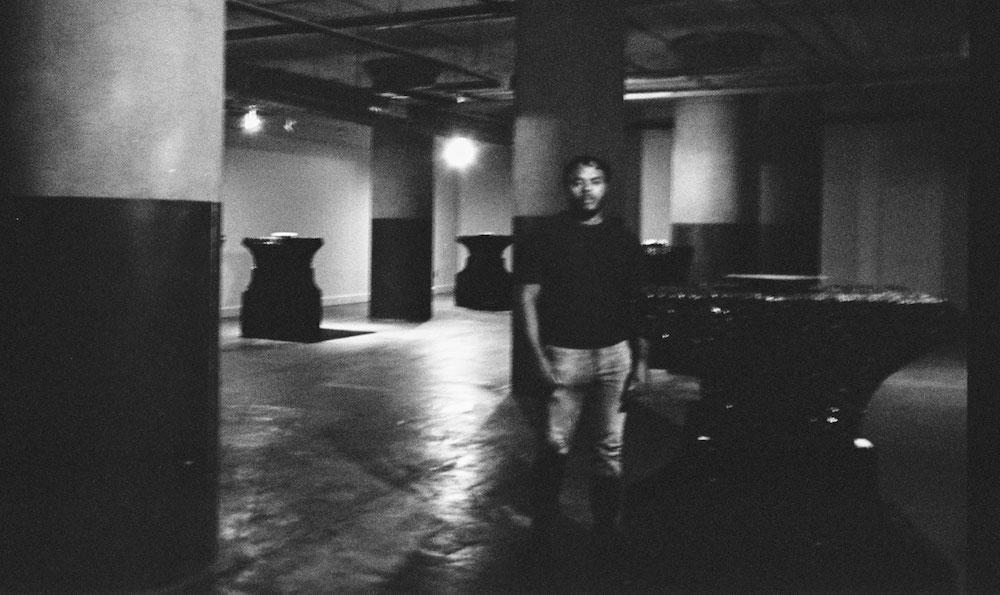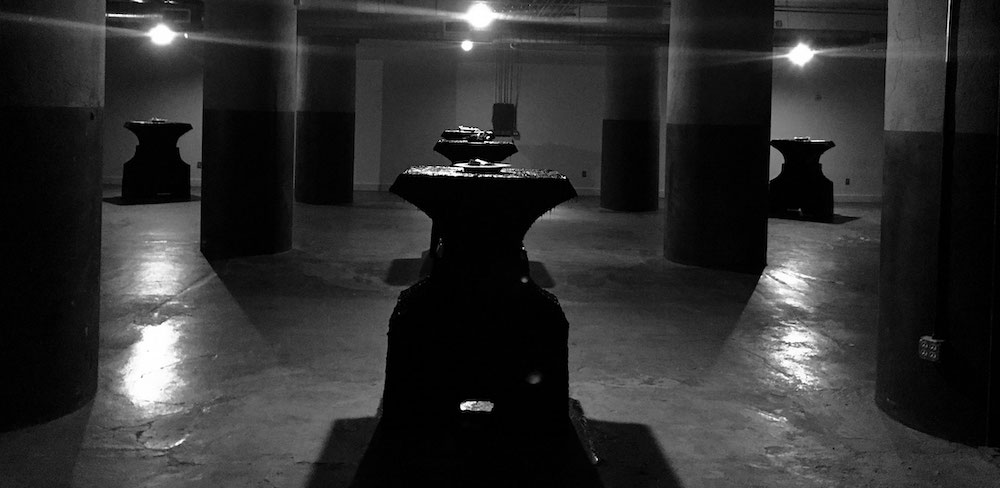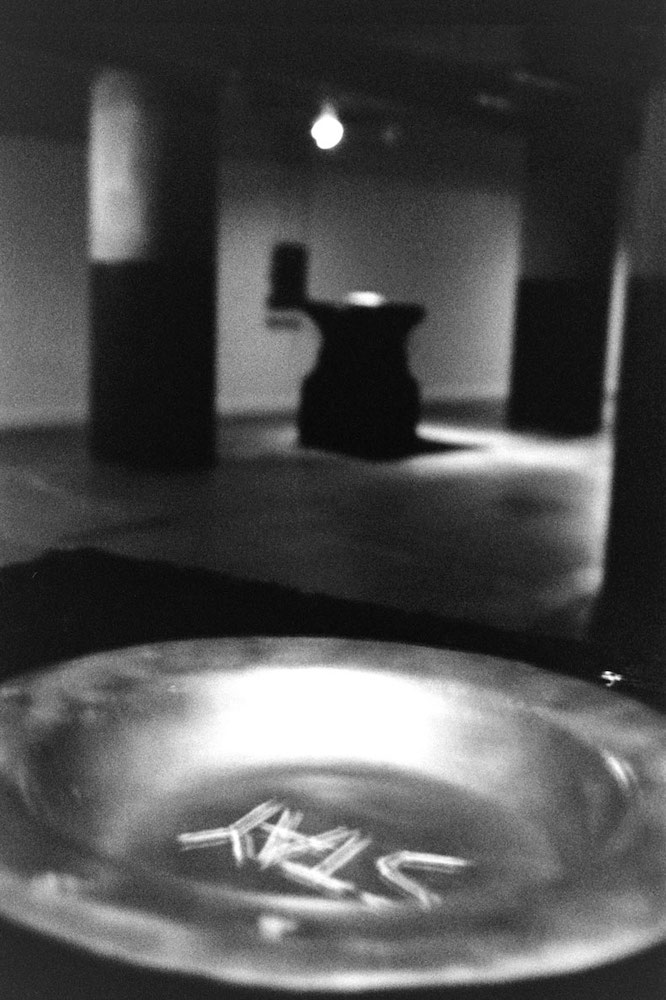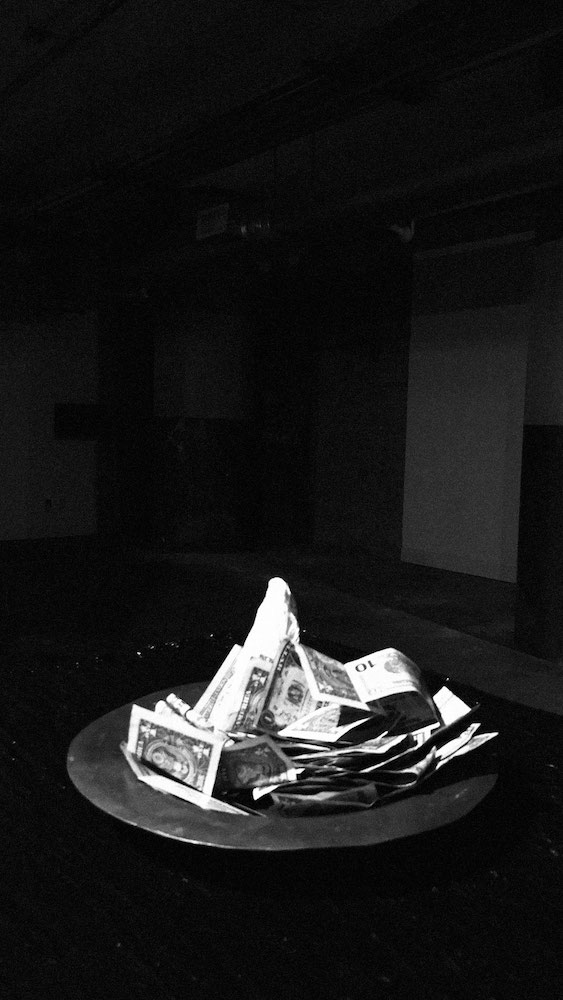The premise to Offerings, David Jeremiah’s latest work, is simple enough. For several months, Janette Kennedy Gallery in Dallas is housing six altars holding six offering plates, each engraved with a part of the phrase “PAY US TO STAY US.” Each altar/plate corresponds to a person killed in Dallas on July 7, 2016 (Micah Xavier Johnson, who is given the plate with the period, and five Dallas police officers). The performance has two rules: (1) Enter the show, (2) Offer money at whichever altar you choose. At the end of the exhibition, Jeremiah will calculate which altar has the most money to determine whose grief is “worth” more, and then deliver the money to the families of the deceased.
While the concept is straightforward — give money to whomever you believe deserves the most grief — the implications are extremely complicated: from calculating the monetary “worth” of grief, to having to be alone with the repercussions of another’s actions (whose altars attract giving and whose don’t); from the power derived from giving money, perhaps anonymously, and thereby “validating” another’s grief, to the power of Jeremiah delivering money to the families of the five police officers; from the inversion of “traditional” performance art — usually the artist performs, the attendants watch — to the artist having his viewers perform. This is all to say that Offerings presents a nuanced and, frankly, terrifying look at the intersection of systemic racism, capitalism, power, and how these things tangle inside each and every person, and especially in the wake of trauma.
Brian Clifton: Something I noticed immediately walking into the gallery is how you used the gallery’s space. The large, concrete pillars make it so a person cannot see every altar at once. That said, Johnson’s altar is visible from almost every angle. I think Offerings is interested in vision and its implication — who is seen, who isn’t, who is memorialized, who isn’t, whose actions are seen, whose aren’t. Could you speak to how you thought through the placement of the altars and how you see the “stage” in conversation with the performance?
David Jeremiah: The principle thought behind placement was the general one in my mind. I’ve had Offerings fleshed-out conceptually going on two years now. Just to keep it a stack.. a nigga didn’t want to waste it. Janette Kennedy Gallery is located in Southside on Lamar. Southside on Lamar is located literally right across the street from a police station. Finding out I had access to that space in particular was what made up my mind about letting the concept go, despite a few other bodies of work/concepts readily available to be shown.
Offerings needs to be shown literally across the street from a police station. It deserves it. The logistics of the altars inside the gallery started off as an homage to sacred ground. I attempted to research online the “actual” series of events that night when Micah had his version of conversation with the cops … and shit was lame on a lot of levels. The main reason obviously being how one-sided the overall perspective was even throughout all of its various discrepancies. I just wanted a who-died-where breakdown of the conversation. I finally found supposedly exactly that on Wikipedia. I thought it was perfect. Wikipedia is conveniently taken seriously just as much as it’s conveniently not taken seriously.
So I was like, fuck it … I might as well at least let some part of what happened remain in a realm probably just as untrue — or more so — as the “credible and unbiased” news platforms that share only what they want. Anybody can edit Wikipedia. Anybody can give to whatever altar they want. Fuck it. So I printed off this numbered map of events on Wiki and used it as a placement guide up against the blueprints of the gallery. Micah had no choice but to be the centerpiece. They always surround you. Symbolically sure — but at the end of the day, my nigga… that’s just a basic tactic. I wanted all of them “aiming” at him. That’s why the altars farthest away are angled in his immediate direction.
But as I’ve been transformed by the installation, I don’t think they’re “aiming” so much so as focused. Finally listening. Hopefully redemption exists past both sides of the grave. 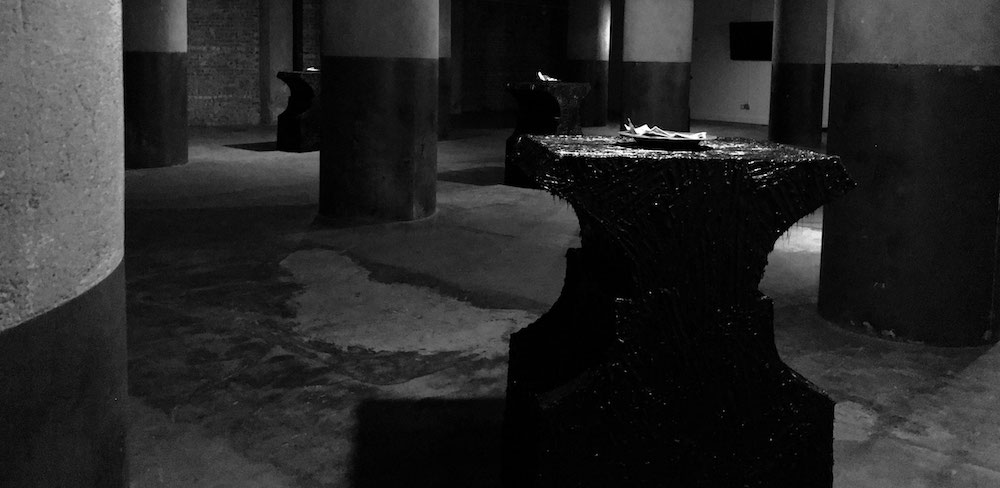
BC: Speaking of focusing, when I walked up to the altars, I could see in the details a confluence of different stuff. The altars themselves have a monolithic, imposing air about them, referencing, as you say in an interview with Aaron Garcia, Modernism and Minimalism (perhaps even Art Deco architecture). They also have a surface treatment that is reminiscent both of some of Theaster Gates’ art (Working Chair, for instance) and coagulated blood, or raised scar tissue. Another thing is that the altars are nearly identical, except for a small bit of color as trim. How do you see the altars speaking to both the aesthetics of the performance and the political implications of the show?
DJ: The color strips tie into my main aesthetic influence: Lamborghinis. I’ve been in love with them ever since I was old enough to have a favorite car. They’re the most beautiful object I’ve ever seen. Not on no weird shit but they’re perfect. There’s very few things I can look at longer. The main thing about Lambos for me conceptually is that once they got past their numerical names, they started coining them after formidable Spanish fighting bulls. If there’s one way to define bullfighting, in my opinion, it’s ritualistic violence. That being said, a nigga could theorize that a Lamborghini’s essence or beauty is rooted in said ritualistic violence.
And if there’s another beautiful, perfect body built for performance and also rooted in “ritualistic violence,” it’s the human body. Any time I reference a Lamborghini color scheme, shape or whatever in a concept/piece, it’s me simply attempting to humanize said concept/piece, specifically in a bodily, more visceral way. Flesh. And the romanticization of its symbolic misuse. We drive our Lamborghinis like bumper cars. What the fuck kind of sense does an almost half-a-mil bumper car make?
BC: That’s an interesting tie — how Lamborghinis and the human body are connected via ritualistic violence. It seems relevant, given Lamborghinis are often synonymous with wealth, to think about how Johnson, as a veteran, and the police officers were essentially paid to cause and be victims of violence. It’s almost as if American capitalism exacerbates racialized violence and the steps necessary to destroy a person (i.e. seeing that person as less than a person, an object). I’m thinking about the phrase on the offering plates, “PAY US TO STAY US.” This phrase can mean a lot of different things (pay us so that we may stay ourselves, pay us in order for us to stay us as opposed to them, pay the US to stay (in) the US, etc.), and maybe there’s a little bit of all these meanings in it. Yet, in all of these interpretations the paying seems fixed in meaning. What connections between money, violence, grief, and worth do you see happening in this work?
DJ: Oil and gold ain’t never have been — nor never will be — more valuable than this race shit. Point blank, period. It’s a racket within a racket. Its worth is super-faceted, though. Better predators have obviously always used it to leverage money, power and all the more readily externally exploitable shit their “talent” affords them — like any other mongering.
But the aspect of said worth that I’ve been tussling with the longest is what we usually categorize within our definitions of identity… Self. Most of my homies I grew up with were on some shit like being down to have a shootout in broad daylight, easy, but wouldn’t step foot in a club that wasn’t on some hood shit because, “they be playin’ that white people music up in that hoe.” Desperation of self like that is way past money and power, nigga. It’s had and has to be, to replace it. Not having the money becomes worth it. The violence becomes worth it. The grief becomes worth it. Because at the end of the day it’s given you something more valuable to you — and that’s a major distinction — than all of the just-listed bullshit that you don’t get to capitalize on in the same way as whoever’s pulling the strings at the top. Identity. You’re not really paying one of the dead cops’ families, or Micah’s family in Offerings. You’re giving to yourself, homie … to your identity to remain itself. So maybe if there were more grieving families from the immediate incident to put more words on, the sentence would go on to say: Pay us to stay us so you can stay yourself.
BC: What’s really refreshing to me about Offerings is its silence. At every gallery opening I’ve been to in Dallas, no one really looks at the art; it’s more of an excuse to network, for people to turn their backs to art in order to gain social capital. With Offerings, visitors are forced to engage with what art can do, what violence can do (and does). I got to the opening late and most of the plates had something in them. It was weird to see that people had given money to the police officers knowing full well that you would have to deliver the money to their families, coupled with the fact that in order to give an offering one had to cover your words — perhaps symbolically silencing you — to support cops. Sitting with that level of violence piled on more violence was profound. Was the support of police something you thought would happen? How have these acts of “all lives matter” shaped your relationship to this performance?
DJ: So racism shouldn’t matter, right? But should it just “not matter” more than it should until it really doesn’t? The shit only seems convoluted because we make it. WHY is it so convoluted is the question that everybody’s scared of. Hell, even me some days. Fuck “All Lives Matter.” Duh, nigga. If they really did then Black lives wouldn’t have to matter a little bit more to fuckin’ catch up. Shit weak. How nice do you really expect me to be to another lie? If you don’t care about respecting me and my mind, then that leaves the responsibility to me, and that’s fair. That’s jungle. I don’t bar going to the cops’ families after the show. Why would I expect anyone else to? And it wouldn’t be “me” anyway. I could only afford to give to one family.
BC: I think that touches on another part of Offerings that really astounds me. The performance speaks to how simple racism is and how convoluted racism can be made. Individually in the performance, a person must choose to support either state-sponsored lynchings or the victims thereof. But collectively, that person also must witness the individual actions of everyone and respond to them as well — which sometimes seems like using a colander to bail out a boat. Do you see bringing these two levels (individual and collective) together as starting to answer the question of why it is so convoluted?
DJ: Conceptually, that’s why I pushed for the shit to literally be open 24/7. I wanted it to solely be about the giving. If you just happen to go there the same time somebody else is there, it’s completely up to you to wait until they’re done just as much as it’s up to them to ask you to do so. If you hate cops and you catch a cop supporter in there taking all the money from the Johnson family altar and re-donating it to one of the cop altars, what are you going to do? If a homeless nigga finds out about the show and comes in the mix on some fuck all this shit type shit and steals all the families’ money, what are we gonna do about it — an issue arguably just as big as police brutality — hunger — that we can’t get around to really fighting over because we’re still stuck on fighting over one that could’ve been fixed already.
I literally want chaos in there. Do you? One of my homies told me he already fucked his girl in there. Like, what the fuck? This doesn’t have to be convoluted. Just like what it’s about doesn’t. Just go in, give, and leave. Or whatever. You don’t have to fuck your girl in there, bro.
BC: There’s also something very “Young Goodman Brown“ about the whole performance. Seeing mostly white and white-passing people go into the gallery and then come out exuberant, I found myself becoming paranoid about who gave money to the cops — how can people come out joyous when confronted by such violence? This is not necessarily a new paranoia for me, a queer Jew, or for others (who is behind the KKK hood?). But when in a performance, it becomes an opportunity for reflection: how do we define ourselves through action and how do we define others through their actions? I think this speaks directly to police brutality — not only who is labeled a “murderer” and who was “doing their job,” but also how often calls for equality (in the arts, in academia, everywhere) become performative. How do you see the idea of “performance” (rather than, say, “installation” or “interactive art”) engaging with the concepts in Offerings?
DJ: I’ve been catching myself writing down a lot of quotes and shit lately. Maybe a nigga trying to get ready to sound all cool and deep for my son. LOL! But one comes to mind that I jotted down a few weeks ago: Man is not good .. He only competes at acting like it. Trash … pessimistic … Yeah, yeah, I know. I definitely gotta shape them shits up before my son knows better, but my point is this: We’re all acting, homie. But as long as we’re acting better who gives a fuck how fake it is?
David Jeremiah’s ‘Offerings’ is on view at Janette Kennedy Gallery in Dallas through September 2020.


